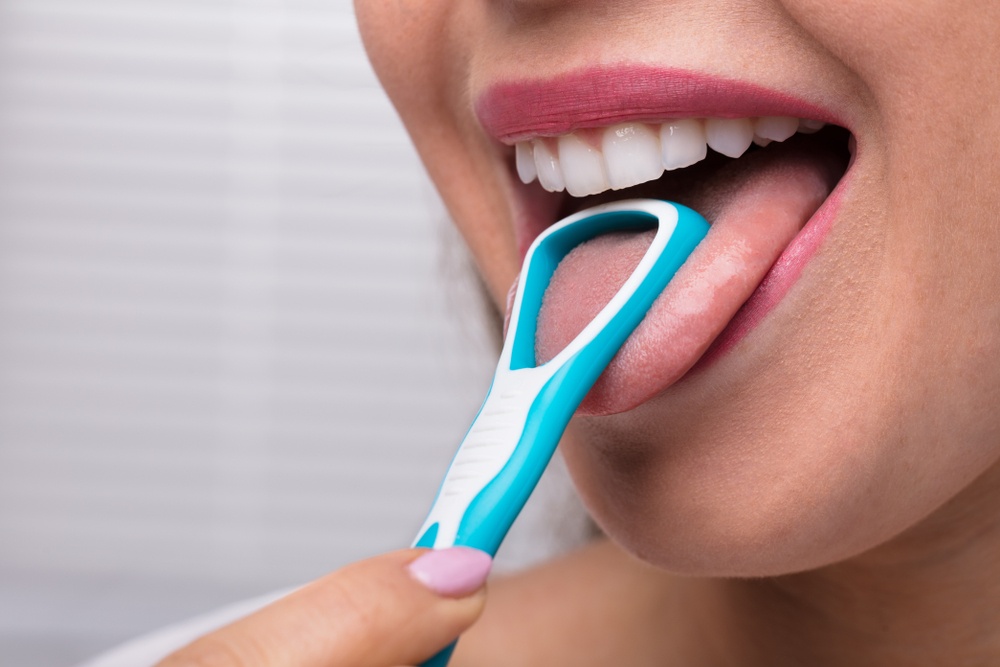
When it comes to oral health, we tend to focus on our teeth and gums. Yet, the tongue plays a number of roles, including helping us speak and eat. What you may not know is that it also reveals a lot about our oral and overall health. Its appearance and, sometimes, sensations (i.e., feeling sore) can give you important information. A healthy tongue is pink in color and covered in tiny bumps (papillae). Changes in how it looks or any pain can indicate a concern and you should schedule a visit with your Naperville dentist to have it checked out. To illustrate just how powerful simply looking at your tongue can be, we’re sharing some of the clues you can gain from its appearance.
Table of Contents
Key Highlights:
- Changes in your tongue’s appearance or tongue discomfort could indicate a health concern.
- Why is my tongue white? A white, coated tongue can be a sign of a number of different conditions, though it’s not usually anything serious. A black, hairy tongue is also not typically a cause for alarm.
- A strawberry tongue, as well as a lump on the tongue, could signal potentially serious health problems.
- It’s always a good idea to bring up changes in the color of your tongue with your dentist.
A White Coating or White Spots on Tongue
Patients often ask, why is my tongue white? A white, coated tongue or white spots on the tongue can be alarming but it’s not usually a sign of a serious condition. Here are a few reasons you may have a white tongue:
- Not Brushing Your Tongue – A coated tongue could just be due to a buildup of bacteria and debris. If the white coating brushes away, that’s probably the case. As for how to get rid of a white tongue, in this instance, simply brush your tongue every time you brush your teeth to keep it clean. As a bonus, this will help fight bad breath too.
- Oral Thrush – A white, coated tongue or white patches can be a sign of oral thrush, which is a yeast infection. It’s caused by Candida yeast (fungus). While we all have Candida in our mouths, when it becomes overgrown, it causes an issue. It’s most common in infants, the elderly, especially those who wear dentures, and people with weakened immune systems. It can also be the result of taking oral or inhaled steroids or antibiotics. Your dentist or doctor may recommend an antifungal treatment, which can come in mouthwash form.
- Oral lichen planus – This type of white tongue looks kind of like you have lace on your tongue and features white lines. Oral lichen planus is a chronic inflammatory condition. It’s not contagious and usually goes away on its own.
- Leukoplakia – Leukoplakia causes white spots on the tongue and inside of the mouth. It crops up when the cells in the mouth grow excessively and it can happen if the tongue gets irritated, such as from drinking alcohol or smoking. It’s not dangerous in and of itself but sometimes it can be a precursor to mouth cancer, so you should schedule an evaluation with your Naperville dentist.
A Hairy, Black Tongue
A hairy, black tongue sounds like something out of a horror movie but it’s actually not usually anything serious. Those tiny bumps on the tongue, or papillae, grow throughout your life. Sometimes, they can get really long, and look almost hair-like. Additionally, when they’re overgown, they tend to accumulate bacteria. The bacteria may look black or dark. The entire tongue can be black or it can start as black spots on the tongue. In most cases, a black, hairy tongue is from poor oral hygiene, but it can also occur due to diabetes, chemotherapy or taking antibiotics.
A Red Tongue or Strawberry Tongue
If your tongue is red or you have a strawberry tongue where it’s swollen, red and bumpy, it could indicate a number of conditions:
- Folic Acid or B-12 Deficiency – If you have a folic acid or vitamin B-12 deficiency, it could result in a red tongue. Bloodwork can confirm if you’re lacking either vitamin. If you’re deficient, changing your diet and/or taking supplements could help you get the necessary vitamins and get rid of a red tongue.
- Kawasaki Disease – A sign of Kawasaki disease is a strawberry tongue (red and bumpy). The disease, which usually occurs in children under five, causes inflammation in the arteries. A strawberry tongue could be accompanied by high fever, a rash, peeling skin, and red eyes. It’s a serious condition, so if your child has these symptoms, seek medical attention as soon as possible.
- Scarlet Fever – Scarlet fever is a bacterial infection that leads to a strawberry tongue. Sometimes, strep throat can turn into scarlet fever. In addition to a bumpy, red tongue, other symptoms include a red rash over most of the body, high fever, sore throat, headache, flushed skin, and red lines in the folds of the skin. It’s most common in children and teenagers. Call your doctor or pediatrician if you or your child has these symptoms because antibiotics will likely be needed to treat it.
- Geographic Tongue – Geographic tongue gets its name because it’s characterized by a map-like pattern. You may have smooth, red, irregularly shaped spots on the surface of the tongue that can have a white border around them. You might also have pain or a burning, especially when eating spicy or acidic foods. The lesions will usually heal and then move to another area of the tongue. Fortunately, the geographic tongue is not serious and it will go away on its own.
- Food or Drug Allergies – Occasionally, a red tongue or strawberry tongue can be from taking a medication or eating a food you’re allergic to. A doctor may give you antihistamines to alleviate the swelling and redness.
A Sore Tongue or Bumps on Tongue
There are a variety of things that can lead to a sore tongue or bumps on the tongue, such as:
- Trauma – If you ever wake up wondering, why does my tongue hurt? You could be grinding or clenching your teeth in your sleep, which can irritate the tongue and cause pain. At Naperville Dental Specialists, we can create a custom nightguard to help with teeth grinding and alleviate tongue pain. A sore tongue can also be the result of accidentally biting it or eating something really hot. In severe cases, eating something scalding could lead to blisters on the tongue. Your tongue will stop hurting once the damage heals.
- Canker Sores – A canker sore on the tongue, or anywhere in the mouth, is painful. This type of tongue ulcer isn’t contagious and it’s thought that stress can bring them on. Canker sores on the tongue tend to heal on their own and should go away in a week or two.
- Smoking – Smoking can irritate your tongue. It can also lead to a yellowish tongue. If it bothers you, use it as motivation to quit!
- Oral Cancer – If you have a lump or sore on your tongue that doesn’t improve within two weeks, even if it doesn’t hurt at all, it could be a sign of oral cancer. You should have it evaluated by your dentist. The early it’s treated, the better.
These are just some of the many clues your tongue can reveal about your oral and overall health. If you notice any concerning changes in your tongue, schedule a visit at Naperville Dental Specialists. Our expert Naperville dentists can determine what’s causing any issues and, if necessary, create a personalized treatment plan to restore your oral health.
































